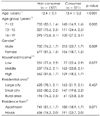Abstract
Instant noodle is one of the most popular foods in Korea. The objective of this study was to examine the association of instant noodle consumption and food and nutrient intake among children and teenagers in Korea. We used dietary data from 24-h recall of 1,748 subjects aged 7-19 years who participated in the 2005 Korea National Health and Nutrition Examination Survey. Those who consumed instant noodle once or more during the survey period were categorized as "instant noodle consumer (INC)" and were compared for food and nutrient intakes with the others (non-INC). The average age of the INC was 13.4 and that of the non-INC was 12.4; girls consumed more instant noodles than boys (p < 0.05). There was no significant difference in BMI between the two groups. With the exception of grains, as compared to the non-INC, the INC consumed significantly less amounts of potatoes, vegetables, mush-rooms, fruits, spices, seafood, and milk and dairy products. With respect to nutrient intakes, the INC-group showed significantly higher nutrient intakes of energy, fat, carbohydrate, sodium, thiamine, and riboflavin; however, as compared to the non-INC-group, the INC-group showed significantly less intakes of calcium, niacin, and vitamin C. The overall result suggests that consuming instant noodles may lead to excessive intake of fat and sodium, but it may cause an increased intake of thiamine and riboflavin. Therefore, nutrition education that helps children and teenagers choose a balanced meal while consuming instant noodle should be carried out. In addition, manufactures of instant noodles should consider nutritional aspects in product development processes.
Figures and Tables
Table 4
Comparison of percentage of dietary reference intakes (DRI)1) and mean adequacy ratio (MAR) by groups (%)

Adjusted for age, household income (1 = low, 2 = middle, 3 = high)
1) Energy intakes were compared with estimated energy requirement(EER), sodium and potassium were compared with adequate intake (AI), and the rest of nutrients were compared with recommended intake (RI)
2) Mean ± SE
*: Significantly different between instant noodle groups at α=0.05 by T-test
References
1. Kim SK, Lee AR. Survey on consumption pattern of Ramyeon in Seoul area. Korean J Dietary Culture. 1989. 4(4):395–404.
2. Kim JK. A study on the Ramyeon purchase behavior of consumers-decision making process of purchase[Thesis of MS]. 1998. Seoul: Dongkook University.
3. Moon SJ, Lee YM. The study of value evaluation of foods in urban adolescents. Korean J Dietary Culture. 1986. 1(2):142–156.
4. Ministry of Health and Welfare. 2005 National health and nurition examination survey report. 2006. Seoul:
5. Kim SK, Lee AR. Survey on consumption pattern of ramyon in Seoul area. Korean J Dietary Culture. 1989. 4(4):395–404.
6. Jang MS, Hwang JH, Hyun YH. Consumption pattern of ramyon by elementary school pupils. Korean J Food Cookery Sci. 1988. 4(2):81–86.
7. Jang MS, Hyun YH, Kim BN. Consumption pattern of ramyon by middle school students. Korean J Food Cookery Sci. 1989. 5(2):91–97.
8. Hyun YH, Kim MH, Jang MS. Consumption pattern of ramyon by high school students. Korean J Food Cookery Sci. 1990. 6(1):61–66.
9. Cho HS, Ahn MS. A survey on the consumption patterns of ramyon by high school students in a part Chun-nam area. J Living Culture Research. 1993. 7(1):43–55.
10. National Council of Consumer Protection Organization. 2000. Seoul:
11. The Korean Nutrition Society. Nutrient database (CD). 2005. Seoul:
12. The Korean Nutrition Society. Dietary Reference Intakes for Koreans. 2005. Seoul:
13. Lee RD, Nieman DC. Nutritional Assesment. 2007. 4th ed. New York: McGraw-Hill.
14. Lee JW, Lee YH. Frequency of instant noodle (Ramyeon) intake and food value recognition, and their relationship to blood lipid levels of male adolescents in rural area. Korean J Community Nutr. 2003. 8(4):485–494.
15. Lee KW, Lee HS, Lee MJ. A study on the eating behaviors of self-purchasing snack among elementary school students. Korean J Food Culture. 2005. 20(5):594–602.
16. Sung SH, Yu OK, Sohn HS, Cha YS. A comparison of dietary behaviors according to gender and obesity status of middle school students in Jeonju. J Korean Soc Food Sci Nutr. 2007. 36(8):995–1009.

17. NongShim Co. LTD. 2009.10.19 search.
http://www.nongshimi.com/nsi/eve/evet_ast_st.jsp.
18. NongShim Co. LTD. 2009.10.19 search.
http://www.nongshim.com/non/pro/prod_eft_viw.jsp.
19. NongShim Co. LTD. 2009.10.19 search.
http://www.nongshim.com/non/pro/safe_eft_idx.jsp.
20. Kim SK. MINIREVIEW: Overview of Korean noodle Industry. Food and Biotechnology. 1997. 6(3):125–130.
21. Melse-Boonstra A, Pee S, Martini E, Halati S, Sari M, Kosen S, Muhilal , Bloem M. The potential of various foods to serve as a carrier for micronutrient fortification, data from remote areas in Indonesia. Eur J Clin Nutr. 2000. 54(11):822–827.

22. Bui LT, Small DM. Folates in Asian noodles: III. Fortification, impact of processing, and enhancement of folate intakes. J Food Sci. 2007. 72(5):C288–C293.
23. Winichagoon P, McKenzie JE, Chavasit V, Pongcharoen T, Goachirapant S, Boonpraderm A, Manger MS, Bailey KB, Waantwisut E, Gibson RS. A multimicronutrient-fortified seasoning powder enhances the hemoglobin, zinc, and iodine status of primary school children in North East Thailand: a randomized controlled trial of efficacy. J Nutr. 2006. 136(6):1617–1623.





 PDF
PDF ePub
ePub Citation
Citation Print
Print






 XML Download
XML Download